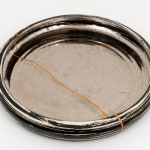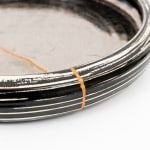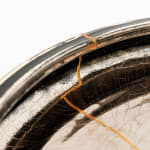


Kintsugi ("golden joinery"), also known as kintsukuroi ("golden repair»),is the Japanese art of repairing broken pottery by mending the areas of breakage with lacquer dusted or mixed with powdered gold, silver, or platinum; the method is similar to the maki-e technique. As a philosophy, it treats breakage and repair as part of the history of an object, rather than something to disguise.
Kintsugi is similar to the Japanese philosophy of wabi-sabi, an embracing of the flawed or imperfect. Japanese aesthetics values marks of wear from the use of an object. This can be seen as a rationale for keeping an object around even after it has broken; it can also be understood as a justification of kintsugi itself, highlighting cracks and repairs events in the life of an object, rather than allowing its service to end at the time of its damage or breakage. The philosophy of kintsugi can also be seen as a variant of the adage, "Waste not, want not".


